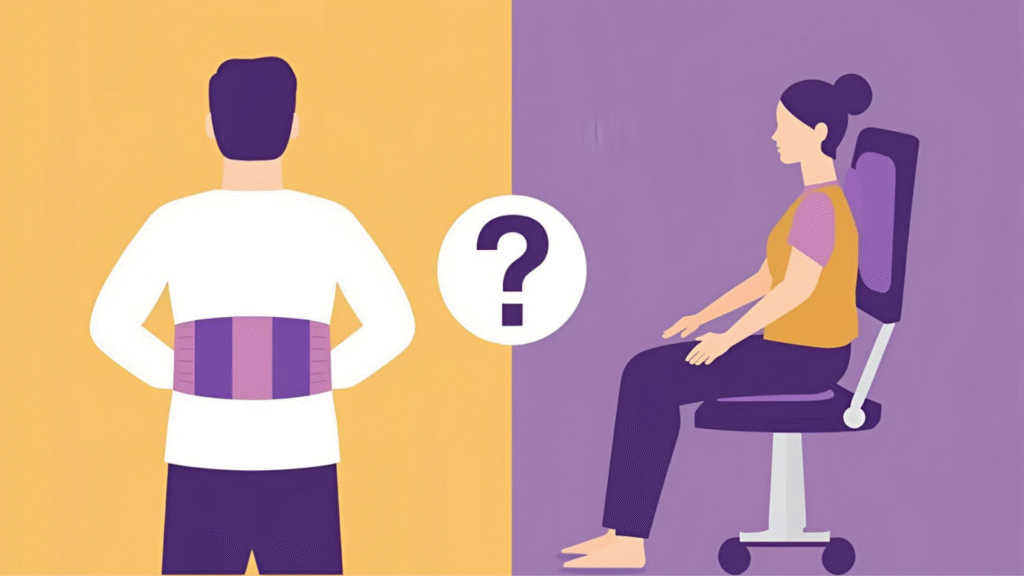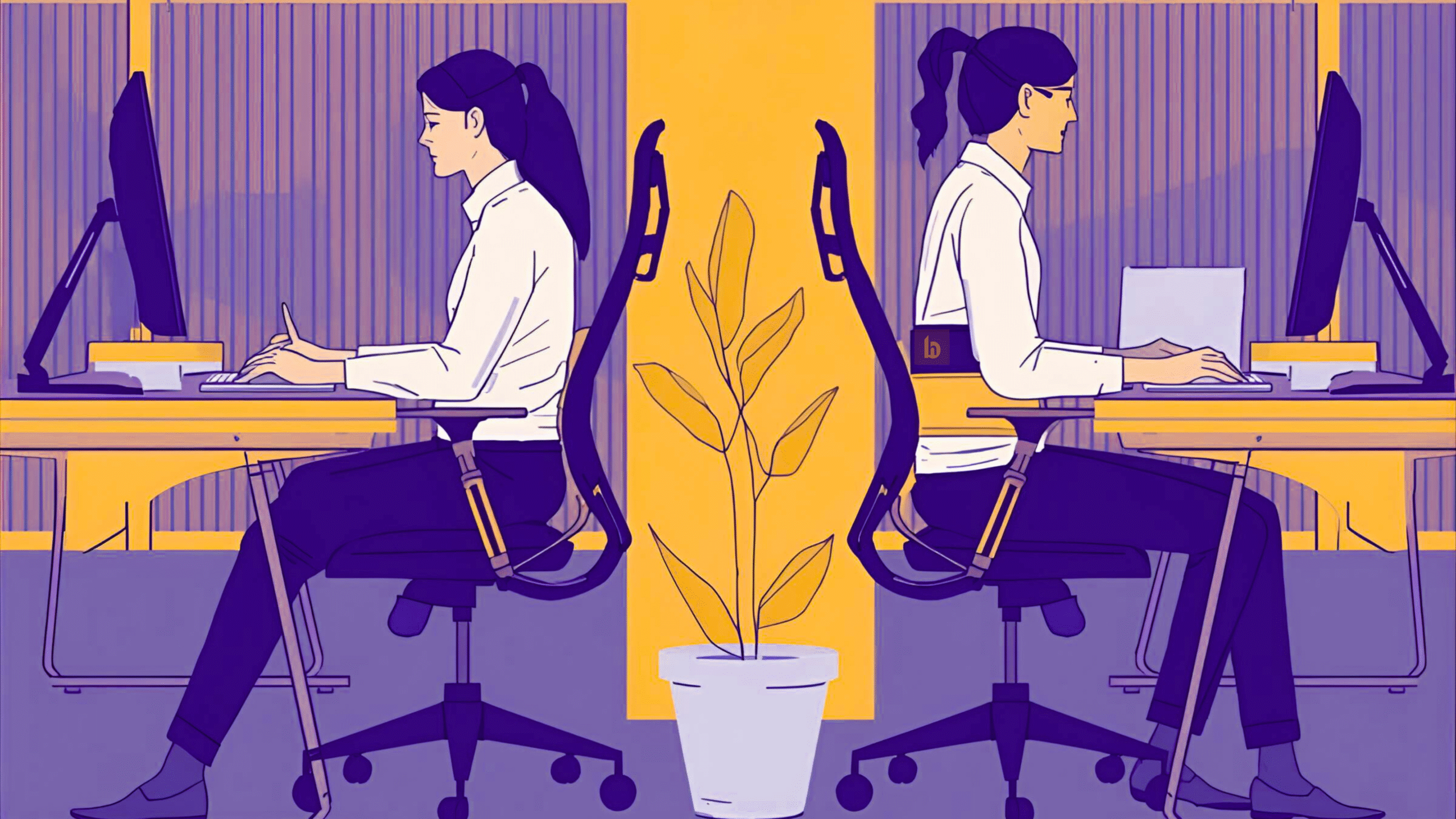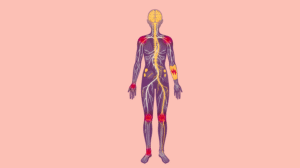If you spend long hours typing, coding, answering messages, or otherwise glued to a screen, then you may have noticed your shoulders creeping forward, your lower back starting to ache, or your neck pretending to be a question mark. At some point you’ve probably wondered: “Do I need a posture corrector belt, or is the right chair enough to save my spine (and sanity)? Well, you’re not alone, many tech workers are in this pickle.
In this article, we’ll explore the science, myths, expert guidance, and real-world data about belts vs chairs vs hybrid solutions. By the end, you should have a clearer idea of what combination (belt, ergonomic chair, both) makes the most sense without spending a fortune, or becoming one of those people who wears belts all day like a medieval knight.
The Techie Posture Crisis No One Talks About
Why Sitting for 8+ Hours Is Silent Damage to Your Spine?
Long periods of sitting, especially in sub-optimal positions, lead to muscle imbalances, joint stress, spinal disc compression, and reduced circulation. The lumbar spine (lower back) is particularly vulnerable when the natural lumbar curve is lost. The tech lifestyle, screens too low, chairs without proper lumbar support, and mid-back slouching, encourage these bad positions.[1]
The Real Cost of “Just One More Hour on the Laptop”
It’s more than just discomfort. Poor posture has been linked to increased risk of musculoskeletal disorders, including chronic neck, shoulder, and back pain. Studies show that even small deviations from neutral posture over time increase joint stress and tissue strain, which can result in long-term damage [2]. Furthermore, the energy cost (in terms of fatigue) is higher, and cognitive performance can dip under physical discomfort.[3]
From Neck Strain to Brain Fog: Posture Impacts More Than You Think
Corporate life demands us to stay seated in front of screens for an extended period of time, which at a certain point leads to affecting our posture. There is evidence that slumped sitting affects mood, blood pressure, stress responses, self-esteem, and overall sense of well-being. One randomized trial found that upright seated posture led to better mood, more arousal, less negative affect under stress, and improved self-esteem [4].
So posture isn’t just about your back , it also tweaks how you feel and how effectively you work.
What Exactly Is a Posture Corrector and How Does It Work?
The Science Behind Belts and Braces
A posture corrector belt or brace typically works by aligning certain body parts such as shoulders, thoracic spine, lumbar spine, etc., offering reminders (through restriction or mild tension) to keep your body upright and in some designs, giving feedback (visual or tactile) to activate underused muscles. The idea is to help corrector wearer become more aware of posture and gradually train muscles, especially those of the upper back and core that tend to weaken when slouching becomes habitual.[5]
These devices vary: some are like harnesses, some have straps, others are shirt-types or even tech-augmented (vibrations, alarms) to cue posture correction. They aren’t magic: they aid proprioception (body awareness), but for lasting change, muscle strength, habits, and ergonomics matter too.
How Ergonomic Chairs Claim to Fix Your Alignment?
Ergonomic chairs are designed to support natural curves of the spine, especially lumbar support; they often include adjustable seat height, backrest angle, armrests, even headrests. Good chairs allow posture variability (i.e. not forcing one rigid posture), encourage micro-movements, reduce pressure on certain areas (like the sacrum, ischial tuberosities), and help distribute load so no one part of your body is overburdened.[6]
Belt vs Chair Mechanisms; Training Muscles vs Supporting Structure
- Belts/braces: They provide external support, help and reduce tendencies to slouch; activate underused muscles via feedback.
- Chairs provide structural support: They create a comfortable support surface designed to maintain spinal alignment, reduce interface pressure, allow adjustability so you can sit upright but with comfort.
- The interaction matters: a good posture belt may be less useful if your chair forces you into bad posture (too low/too high, no lumbar support). A great chair cannot entirely compensate for weak back muscles or habitual slouching if you ignore posture altogether.
The Big Face-Off: Posture Corrector Belt vs Chair

Comfort Battle: Which Feels Better for Daily Tech Life?
Belts can feel restrictive, warm, and sometimes uncomfortable if worn too long; chairs may pressure certain points (back of thighs, lower back) if poorly designed. While belts are more usable for shorter durations or act as lil reminders , many people find that a well-adjusted ergonomic chair gives more comfort over long sessions.
Portability and Flexibility: Belt in Your Backpack vs Chair in Your Office
One big advantage of posture belts: portability. Whether you’re moving among desks, traveling, or working remotely, a belt travels easily. Chairs are fixed; investing in a good one is heavier, more costly, and less portable. If your work environment changes (co-working spaces, cafés), a belt might have more immediate utility.
Price War: Budget-Friendly Fix or Long-Term Investment?
High-quality ergonomic chairs (with adjustable lumbar support, tilt, armrests) often cost significantly more than a decent posture belt. But chairs tend to have longer lifespans and may deliver benefits without needing constant use. Belts can be cheaper up front, but worn-out straps, comfort issues, or poor fit might make them less durable or effective over time.
Which One Delivers Faster Results for Tech Workers?
If you experience mild issues like occasional discomfort, a slightly rounded shoulder while stting then a belt might deliver a fast cue-based fix: you put it on, it reminds you to sit up, and you adjust. But for more stubborn issues (chronic lower back pain, muscular imbalance), an ergonomic chair that supports natural posture plus a strengthening regime tends to show more durable change. Scientific reviews suggest furniture design and ergonomic chairs reduce musculoskeletal pain in office workers more reliably than belts alone.[7]
The Shocking Truth About Posture Correctors for Techies
Why Do Most Belts Fail When Used Wrong?
Belts/braces will not correct posture if you don’t use them correctly. Wearing them for too long, setting them too tight, not combining with exercise or ignoring their cues can backfire: it might reduce muscular activation or cause discomfort or compensate badly elsewhere (like over-arching lower back). Also, wearing them overnight or during inappropriate activities can strain skin or joints.
Physical therapists caution: belts are reminders, not substitutes for muscular control.
The Limits of Even the Most Expensive Chairs
Even a top-tier ergonomic chair has its limitations. If you slouch, if your chair is misadjusted or you stay in one static posture for many hours, you still risk discomfort. Chairs support structure, but they don’t (by themselves) strengthen muscles or fix poor habits. Also, ergonomic support must be tuned specifically to your body size and tasks. Studies show high variability in “most comfortable” sitting posture across individuals, with meaningful differences in trunk angle, knee angle, etc., between chair types and people.[8]
Why Quick Fixes Rarely Solve Long-Term Tech Struggles?
Using a posture corrector belt for a few days or switching to a better chair for a week isn’t usually enough. Muscular imbalance, joint stiffness, and postural habits build over months or years; so fixing needs time: strength training, regular breaks, posture awareness, and supportive furniture all need to be part of the plan. Short-term fixes may ease pain but often don’t sustain.
What are the Posture Corrector Myths that keep Techies Stuck ?
“Wearing a Belt Will Magically Fix My Back”?
There is no scientific support for the idea that a posture corrector by itself (belt or harness) will magically reverse all posture issues without addressing muscle strength, ergonomics, and habits. Belts can help you with your body alignment and make you aware about it, but the lasting change requires more (exercise, smart postural habits).
Health sources caution that for serious conditions (e.g., scoliosis, severe back pain), one should consult medical professionals rather than rely only on braces.[9]
“A Premium Chair Means Perfect Posture”; Not Really
Many believe that spending more money on a chair automatically fixes posture. But unless the chair is adjusted well, matches one’s anthropometry (body size, leg length, height, weight), and is used with awareness and occasional movement, even premium chairs may not help. Ergonomic furniture studies show that poorly matched chairs contribute to misalignments, discomfort, and MSDs.
What Research Actually Says About Belts and Chairs?
Systematic reviews are mixed: some support posture correctors as useful adjuncts (especially to reduce discomfort, increase awareness) but evidence is less strong on long-term structural improvements without other interventions. By contrast, ergonomic chairs with adjustable features have more consistent data for reducing musculoskeletal pain in office workers, improving pressure distribution, increasing comfort and productivity.
Do You Really Need a Chair If You Already Own a Belt?
Situations Where a Belt Alone Works Fine
- Mild discomfort or posture drift (your shoulders slouch during long video calls)
- Short-term tasks where you cannot change your furniture immediately
- When you have a good chair already but need extra reminders (belt as cue device)
- As support during certain activities (driving, commuting, walking), where a chair doesn’t help
When an Ergonomic Chair Becomes Non-Negotiable?
- Persistent back or neck pain despite using a posture corrector belt
- If you spend many hours consecutively seated at a desk
- When your current chair lacks lumbar support, adjustable seat, tilt or armrests
- If you experience numbness, tingling, or discomfort in legs, hips, lower back
Why the “Either/Or” Debate Might Be a Trap ?
Belts and chairs are not mutually exclusive; often using both (plus good habits and exercise) yields better outcomes. Treating posture as a package rather than choosing a side can help: structural support + reminders + muscle strengthening + movement = best chance of lasting good posture.
Expert Verdict: What Chiropractors and Physiotherapists Recommend?
Physical therapists and ergonomists generally say: posture correctors (belts) can be useful tools but only when used thoughtfully, for limited durations, and as part of a broader regimen that includes strength training, stretching, and frequent breaks.
They also emphasize that ergonomic chairs are foundational for those in sedentary tech roles — because they reduce load on the spine, maintain neutral alignment, and allow variation in posture. Weakening of back and core muscles is a major risk factor, so belt alone is insufficient for moderate to severe posture issues. In some clinical studies, using scapular braces (upper back braces) helped improve posture in controlled settings, but again, only for certain durations and combined with exercises.[10]
Real Techie Experiences With Posture Correctors
Ravi, a software engineer, started using a scapular posture belt at work. Within weeks, he noticed his shoulders opening up and less tension in his back and hips .
Priya, a project manager, switched to an ergonomic chair with lumbar support. Her lower back discomfort decreased, and long planning sessions felt much easier on her spine.
Ankit, a data analyst, realized even the “most comfortable” chair wasn’t enough, he kept drifting forward. Combining a posture belt with micro-breaks and stretches helped him maintain better alignment .
Hybrid Solution: Belt + Chair = Maximum Relief?
Using a Belt for Work Calls and Quick Sessions
You can wear a posture corrector belt for periods where you tend to slouch (video calls, reading) as a cue device, reminding your shoulders, upper back, cervical to hold alignment. Use it intermittently (say 30-60 minutes at a time), not continuously, to avoid dependency.
Relying on an Ergonomic Chair for Long Coding Hours
When you have long stretches of desk work, nothing substitutes for a chair that supports your spine: good lumbar support, seat depth & height adjustable, backrest tilt, possibly headrest, armrests, etc. These structural elements help reduce risk of fatigue, pressure, and misalignment.
Desk Ergonomic Hacks That Amplify Both
- Adjust monitor height so the top of the screen is roughly at eye level.
- Keep keyboard and mouse at proper height (forearms nearly horizontal).
- Feet should rest flat on floor or footrest; thighs at ~90-100°, knees at ~90° angle.
- Use timer reminders to break every 30-45 minutes: stand, stretch, walk.
- Incorporate core and upper back strengthening exercises to make posture correction effective beyond external aids.
Posture Corrector Fails: Why Techies Give Up Too Soon?
Common Mistakes That Kill Your Progress
- Wearing the belt too loosely (so it doesn’t serve as a reminder) or too tightly (causes discomfort).
- Using the belt continuously for too long; leading to reduced muscle activation (i.e. letting the device do the work).
- Relying on chair/ belt without movement, breaks, or ignoring environmental factors (desk height, screen position).
How to Actually Train Your Body With a Belt?
- Use belt as cue: wear for certain tasks; after some time, try doing the same tasks without belt and maintain posture.
- Alternate wearing and not wearing.
- Combine with exercises: upper back strengthening (e.g. rows, scapular retraction), core strengthening, mobility work.
The Patience Factor: Why Results Take Weeks, Not Days?
The physical structure (muscles, ligaments) of our body adapts slowly. Even small postural habits that have existed for months or years take time to adjust. Studies often see measurable improvements over several weeks to months. So consistency matters more than perfection.
Are Posture Correctors Just a Gimmick or a Smart Tech Investment?
How to Spot Overhyped Marketing Claims?
Watch for promises like “completely solves lower back pain in 24 hrs,” “one belt fits all,” “wear overnight for dramatic results.” These are usually red flags. Good vendors will explain proper use, show realistic outcomes, and often reference scientific or medical backing.
What Research Actually Confirms About Posture Devices?
- Devices that give feedback (visual, tactile) can help increase awareness of posture and reduce discomfort in short-term studies.^
- Ergonomic chairs with lumbar support, adjustability, backrests with proper contouring are better at reducing musculoskeletal discomfort than generic chairs.
- Studies also show that static posture, even in “good” chairs, is problematic; posture variability and movement are important.
How to Tell if You’re Wasting Money or Making a Smart Choice?
- Does the posture corrector belt allow adjustability, breathable materials, correct sizing?
- Does your chair have lumbar support, adjustable seat height, and backrest, etc?
- Is there infrastructure for breaks, movement, exercise in your schedule?
- Are you tracking discomfort/pain or posture over time to see if improvements occur?
The Lazy Techie’s Guide: Easy Desk Hacks That Beat Any Belt or Chair
Since some of us (me included) are lazy, here are hacks that work even if your chair is average and belt is just a backup:
- Desk Yoga Moves: Shoulder rolls, chest openers, neck stretches every hour clears tension.
- Standing Breaks and “Micro-Movements”: Even standing for 2 minutes or walking around after 30-45 mins of sitting help reset posture.
- Laptop Stands, Footrests, Proper Monitor Height: Small adjusters under laptop, external keyboard, using footrest if feet don’t reach ground.
These tweaks help reduce pressure, improve alignment, and support whatever belt or chair you use.
Final Verdict – Belt or Chair: What’s Really Best for Techies?
Here’s what scientific evidence + experts suggest:
- If you’re mostly sitting, and spend many hours at a desk, an ergonomic chair is foundational. It’s the base you build everything else on.
- Use a posture corrector belt as a supplementary tool: for reminders, awareness, during tasks you tend to slouch. But don’t expect it to do all the work.
- Best outcomes come from a hybrid approach: good chair + occasional belt + habits + exercises + movement breaks.
If budget constraints force a choice, invest first in a chair with lumbar support and adjustability. Use the belt selectively. Over time, strengthen your core and back so that external aids become less necessary.
Bonus Takeaway: Small Daily Habits That Outperform Any Gadget
- Movement is king. The more you change posture, stand up, stretch, walk, the less burdened your back is.
- Sleep posture and pillow choices matter; alignment at night can influence how your muscles wake up.
- Practice posture awareness: mirror checks, phone alarms, buddy reminders, these low-tech cues are surprisingly powerful.
Conclusion
For techies, the posture battle is real but you don’t have to pick sides blindly between a posture corrector belt and an ergonomic chair. The science suggests: use both (when feasible), choose what fits your body and work style, make movement and breaks non-negotiable, and treat posture as a habit, not a one-time fix.
Explore More Health & Wellness Solutions
Want to stay informed about wellness and everyday health issues? Here are some insightful reads to guide you. Explore the links below for practical tips and solutions:-
- https://betterhood.in/learn/tech-neck-relief/
- https://betterhood.in/learn/5-minute-stretching-routine-for-desk-workers/
- https://betterhood.in/learn/do-lumbar-support-belts-really-work/
- https://betterhood.in/learn/building-stronger-bones-and-joints-after-30-the-role-of-protein-and-calcium/
- https://betterhood.in/learn/workplace-stretches-to-prevent-chronic-pain/
So, the next time you find yourself hunched over trying to debug code at 2 AM, remember: adjust that chair, maybe strap on the belt for a bit, stand up, stretch and don’t beat yourself up. Your spine will thank you.
Frequently Asked Questions:
1. What is a posture corrector, and how does it help tech workers?
A posture corrector is a belt or brace designed to align your spine, shoulders, and upper back. For tech workers, it acts as a reminder to sit upright, reducing slouching and associated neck or back discomfort.
2. Can a posture corrector belt replace an ergonomic chair?
Not entirely. Belts provide cues and mild support, but chairs offer structural support for long hours of sitting. Using both together often gives the best results.
3. How long should I wear a posture corrector each day?
Experts recommend wearing it for short periods (30–60 minutes at a time) to train muscles and reinforce good posture without creating dependency or discomfort.
4. Are expensive ergonomic chairs worth it for tech workers?
Yes, if properly adjusted. Studies show chairs with lumbar support, adjustable height, and tilt can reduce back strain and maintain spinal alignment better than standard chairs.
5. Will using a posture corrector cure chronic back pain?
No. Posture correctors help with awareness and support but cannot replace medical treatment. Chronic pain may require a combination of ergonomic solutions, strengthening exercises, and professional guidance.
6. How can I make a posture corrector and chair work together effectively?
Use the belt as a reminder for short tasks and combine it with a properly adjusted chair. Include regular breaks, stretches, and exercises to strengthen your core and back muscles for long-term results.
References:
- Zhang, C., Wang, J., Wang, G., et al. (2023). Biomechanical effects of different sitting postures and physiologic movements on the lumbar spine: a finite element study. Journal of Biomechanics, 148, 111541. https://doi.org/10.1016/j.jbiomech.2023.111541 PubMed
- Kett, A. R., Sichting, F., & Milani, T. L. (2021). The effect of sitting posture and postural activity on low back muscle stiffness. Biomechanics, 1(2), 214-224. https://doi.org/10.3390/biomechanics1020018 MDPI
- King, A., & Pruce, A. (2016). Effects of a sit-stand-walk intervention on musculoskeletal discomfort, productivity, and perceived physical and mental fatigue, for computer-based work. Applied Ergonomics, 57, 45–52. https://doi.org/10.1016/j.apergo.2016.02.010 ScienceDirect
- Nair, S., Sagar, M., Sollers, J., Consedine, N., & Broadbent, E. (2015). Do slumped and upright postures affect stress responses? A randomized trial. Health Psychology, 34(6), 632–641. https://doi.org/10.1037/hea0000146
- HSS Health Library. (2021). Do Posture Correctors Work? Expert Advice from a PT. Hospital for Special Surgery. https://www.hss.edu/health-library/move-better/do-posture-correctors-work Hospital for Special Surgery
- Secretlab / Herman Miller et al. (n.d.). The Science Behind Ergonomic Chairs / The Science Behind Ergonomic Office Chairs. Secretlab. Herman Miller. https://secretlab.co/pages/ergonomics / https://store.hermanmiller.com/ergonomics-in-the-workplace-office-chairs.html?lang=en_US Secretlab US+1
- van Niekerk, S. M., Louw, Q. A., & Hillier, S. (2012). The effectiveness of a chair intervention in the workplace to reduce musculoskeletal symptoms: A systematic review. BMC Musculoskeletal Disorders, 13, Article 145. https://doi.org/10.1186/1471-2474-13-145 BioMed Central
- Chen, Y.-L., & Zhang, L.-P. (2025). Postural variability in sitting: comparing comfortable, habitual, and correct strategies across chairs. Applied Sciences, 15(13), Article 7239. https://doi.org/10.3390/app15137239 MDPI
- Ng, S. Y., Lung, T. H. A., Cheng, L. Y. J., & Ng, Y. L. E. (2022). Brace prescription for adult scoliosis: Literature review. The Open Orthopaedics Journal, 16, 212–225. https://doi.org/10.2174/18743250-v16-e2205270 openorthopaedicsjou
- The Indian Journal of Occupational Therapy. (2020). Effect of upper back brace with auditory feedback. The Indian Journal of Occupational Therapy, 52(30). https://journals.lww.com/iopt/fulltext/2020/52030/effect_of_upper_back_brace_with_auditory_feedback.2.aspxLippincott



















